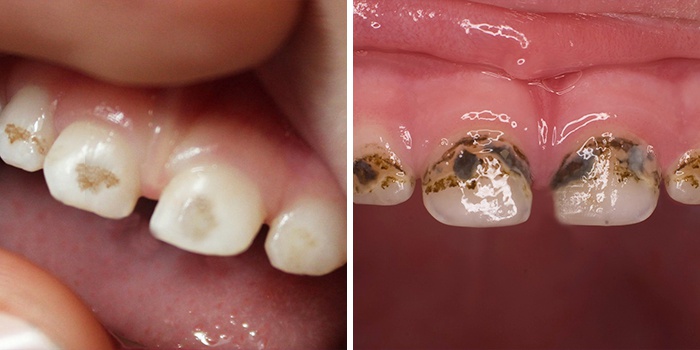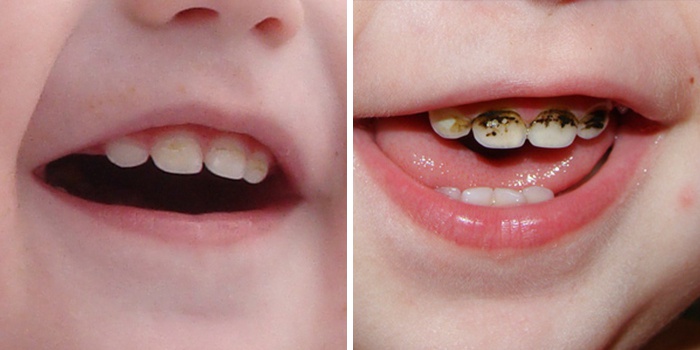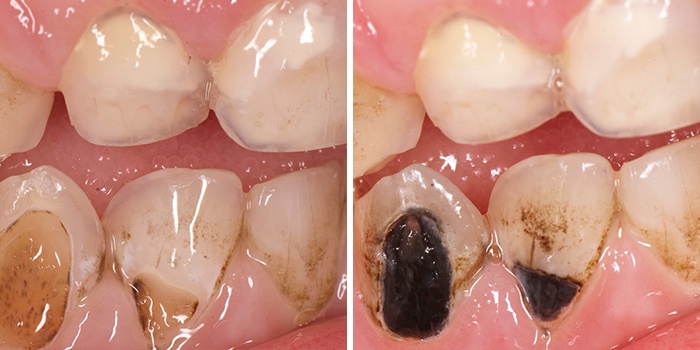A child's fragile baby teeth are most susceptible to developing caries. Firstly, the enamel of such teeth is still quite soft; cracks and holes easily form on it, ideal for the accumulation of microbes. Secondly, few parents teach preschool children oral hygiene, which gives bacteria everything necessary conditions for development. This is why protective techniques for baby teeth are popular these days, one of which is silver plating.
Silvering teeth for children (photo below) is carried out to prevent the development of caries and gum disease in the early stages.
This also allows you to delay regular trips to the dentist, so in the future children will not perceive the manipulation room as a place for “torture.” Kids don’t want to sit quietly for more than 10 minutes, especially when the “scary uncle” in a white coat tries to put iron instruments in his mouth. But the silvering procedure does not cause such unpleasant associations.
The silver plating procedure does not cause unpleasant associations
Keep in mind that, unlike other dental procedures, silvering cannot be done at home using improvised means. The thing is that the material can react with plaque, which in the future will cause complications when cleaning your teeth.
Many doctors have encountered a situation where parents are trying to use the service for financial gain, rather than being guided by the dentist’s testimony. Some people simply do not have the time and money to regularly take their child to the dentist, buy him expensive toothpastes and special brushes.
This measure is indicated only when demineralization of the enamel becomes noticeable until it is deeply damaged. That is, the procedure is prescribed in the early stages of dentin damage.
If an unqualified doctor offers a service at an advanced stage of the lesion, then silver can reach the pulp and simply destroy it. Pulp death occurs asymptomatically, without causing discomfort or pain. Therefore, neither the baby nor his family notice anything until the tissues decompose and possible occurrence gangrene.
So, the reasons for prescribing the teeth silvering procedure for children:
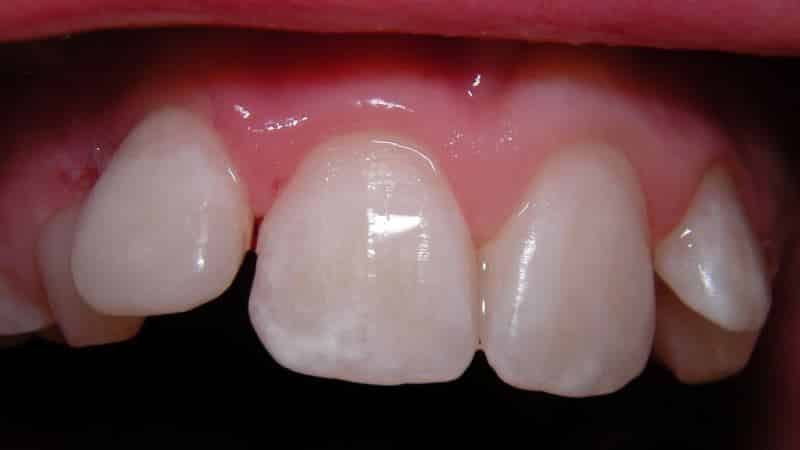
Advantages and disadvantages of the procedure
Let's look at the pros and cons of silvering baby teeth (before and after photos are shown below).
Let's start with positive impact enamel material:
- The procedure itself is very simple, quite quick and absolutely painless, which will not cause unpleasant associations with the dental office in the child.
- The material used for manipulation is environmentally friendly and natural, does not contain toxins, impurities or highly allergenic components.
- The method is accessible to the middle class and gives a long-lasting effect, which relieves parents of the need to take their baby to doctors every month.
- Is in a great way prevent the development of caries, destruction of teeth and enamel, the formation of chips and cracks on it.
- Silvering allows you to delay the disease just long enough for the baby to grow up and change baby teeth to molars.
Let's now take a look at the negative consequences and features of the event:
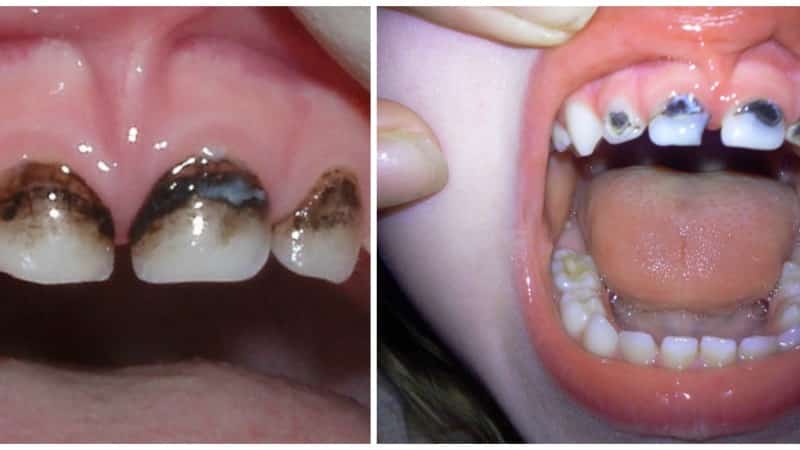
The essence of the event and stages of implementation
Silvering of baby teeth in children is carried out using antiseptic composition– silver nitrate.
The event is indicated for children over 2.5 years old, when the bite is fully formed.
So, the baby receives a doctor’s consultation, indications, contraindications and possible allergies on the material used and antiseptics. Anesthesia and the use of abrasive materials during manipulations are not provided.
Next, take a cotton pad soaked in a special medical solution. It wipes the surface of the enamel, after which a gray coating appears on it. By the way, the procedure is carried out only on the smooth part of the tooth, avoiding use on the chewing area.
The plaque is fixed, resulting in the appearance of a dense dark film that prevents the proliferation of pathogenic microflora, cariogenic microbes, etc.
In addition to silver nitrate, other preparations containing silver and fluorine began to be used for manipulation. Popular products include Arginate and Saforide. Their active ingredients react with enamel and dentin, resulting in the formation of calcium fluoride and silver phosphate. They clog the dentin channels, thereby destroying germs and bacteria.
Above we looked at how and why children’s teeth are silvered. It remains to establish how often the procedure should be performed.

But still, the number of sessions will depend on other factors: the type of feeding (breastfeeding, complementary feeding, artificial feeding), the age of the baby, dietary features, regularity of necessary oral hygiene, etc.
Contraindications for the event:
- in the baby’s diet, as well as the water he drinks, there is high content fluorine;
- caries in the middle or deep phase.
Other types of tooth preservation from caries
Since the silver plating method is considered obsolete in most European countries, a lot of alternative options to preserve the health of baby teeth. They involve a more modern and relevant approach to the procedure, allowing you to achieve long-lasting results without the use of unaesthetic materials.
Before silvering your child’s teeth (photos are presented below), you should familiarize yourself with other similar procedures, such as fluoridation, remineralization, ozonation, fesure sealing, etc.

Whatever method you choose for yourself, remember that dental procedures do not replace competent daily hygiene child's oral cavity. In addition to caries, other pathologies and diseases can lie in wait for a young body, such as periodontal disease, periodontitis, fistula, stomatitis, etc.
The general health and well-being of a child depends on many factors, and one of them is the condition of baby teeth. It is very important to visit your dentist regularly for preventive purposes so that you have the opportunity to prevent possible problems in time.
What you need to know about baby teeth
It should be remembered that children's milk teeth are not as strong as permanent teeth, and therefore are more susceptible to decay and caries. Never miss a situation, because if the disease reaches the nerve located under the crown, it will cause severe pain and perhaps the fear of going to the doctor. In addition, caries is a problem not only for children’s teeth, but also for the digestive system, immunity, and bite. Needless to say, a severely affected tooth will have to be removed ahead of time. But an even milk bite is the key to the health and shape of molars. If you find signs of decay on your child’s teeth, contact the pediatric therapeutic dentistry department as soon as possible. Do not be afraid that caries will certainly be treated using a drill that frightens many. Today there is such a method as silvering.
Silvering tasks
Silvering of baby teeth is a modern dental procedure that is actively used to prevent and stop the progression of the initial stage of caries, as well as in cases of enamel underdevelopment. This method will help avoid premature tooth decay caused by various factors. For example, young children do not yet fully master oral hygiene skills, so they cannot thoroughly clean plaque that accumulates throughout the day. The condition of children's teeth is greatly influenced by an unbalanced diet with a low content of vitamins and minerals, consumption of various sweets containing simple carbohydrates(cookies, sweets, crackers). It is also harmful to drink a lot of sweet drinks (compotes, juices, soda). Babies should be gradually weaned off night feedings.
Features of the method
Silvering teeth in children is a fairly popular procedure among parents, as it is known for its non-invasiveness. It does not require anesthesia or the use of a drill. The essence of the silvering method is that the surface of the teeth is treated with special substances that create a protective film and prevent the penetration of pathogenic cariogenic microorganisms into the deep layers of enamel and dentin. The popularity of silvering baby teeth can easily be explained by the fact that this procedure is quite simple, is carried out quickly and does not cause discomfort. But this is very important so that in the future the child will not be afraid of visits to the dentist. But it should be remembered that if caries has become pronounced, dark spots and pulp damage occurred, then this method is no longer used, a full-fledged one is required therapeutic assistance, and in some cases tooth extraction.
Preparations for silvering baby teeth
Initially, in pediatric therapeutic dentistry, a drug based on silver nitrate (30%) was used to silver teeth in children. This compound has a pronounced antiseptic effect. Currently, new products have been developed that are highly effective and have a gentle effect on the child’s body. The MARTINKA dental clinic uses drugs that contain silver and fluoride. The general term for these is silver fluoride diamine, but it is available under different names. trade names(“Argenat”, “Saforaid”, etc.). The effect of these drugs is based on the reaction active substances with dentin and tooth enamel. As a result of the interaction, silver phosphate and calcium fluoride are formed, which are able to close dentinal tubules and suppress the activity of cariogenic microorganisms. Thus, silvering teeth makes them more resistant to acids produced by bacteria that destroy enamel.

How often can the procedure be performed?
All parents worry about the health of their children, so they ask themselves: how often can baby teeth be silvered? The frequency of this procedure is determined by the dentist individually. As a rule, it depends on the child’s age, dietary habits, and level of oral hygiene. On average, silvering of baby teeth can be carried out from once a month to once every six months.
Is it possible to carry out the procedure at home?
Most children are afraid of going to medical institutions and especially in dentistry. At the same time, the procedure for silvering teeth in children seems quite simple and quick. Therefore, many parents have the assumption that they can buy a special drug and apply it at home, without the help of a specialist. But this is absolutely forbidden. A person who does not have sufficient knowledge and skills will not be able to determine the depth of tooth damage and the need for treatment. In addition, do not forget that the procedure may have contraindications that only a doctor can identify. The aesthetic side of the problem is also important: if the teeth are not thoroughly cleaned before silvering and the coating is unevenly coated with the composition, an unsightly appearance may appear. dark coating, which is almost impossible to remove.
Our offer
The MARTINKA clinic encourages you to regularly visit dentistry for preventive purposes from the moment your baby’s first milk teeth appear. Our specialists conduct thorough examinations, can detect the problem in a timely manner and help solve it using the teeth silvering procedure, and most importantly, painlessly. We pay very close attention to our young patients so that they do not have any fear when visiting the dentist.

Prices for silvering baby teeth
If you want to make an appointment at the MARTINKA dental clinic and find out the prices for silvering baby teeth, call the phone number indicated above.
Lydia, 32 years old
Question:
Hello! Caries associated with insufficient mineralization of enamel is a problem for all members of my family. My youngest son is now 2 years old, will silver plating help prevent his teeth from decaying?
Answer:
Regular silvering of teeth (according to the schedule prescribed by the attending physician) can prevent the development of caries and, therefore, preserve baby teeth until the time they fall out naturally. But tooth decay caused by mineral deficiency cannot be eliminated by silvering. Modern formulations include some minerals that help restore enamel, but for full recovery mineral components in tooth tissues, it is necessary to use comprehensive measures.
Ivan, 29 years old
Question:
My daughter (4 years old) has the initial stage of caries on the last tooth located in the upper lateral row. Filling is excluded - my daughter is afraid of the drill. Does it make sense to carry out silvering or is it easier to persuade the child to remove the tooth?
Answer:
The decision to perform the procedure is made by the attending physician. Depending on how damaged the tooth tissue is, this procedure may be undesirable or even contraindicated. But the silvering of the rest, still healthy teeth, will definitely allow you to preserve them and prevent the formation malocclusion because of early removal milk teeth.
Galina, 30 years old
Question:
Hello! Is it possible to silver plate permanent teeth a 7 year old who is afraid of the drill?
Answer:
Silvering is only a temporary measure that allows you to preserve baby teeth until the age of the child when he becomes possible to carry out full-fledged dental treatment. Explanatory conversations should be held with children over 3-4 years of age that will allow the child to understand the need for dental treatment.
Ruslan, 35 years old
Question:
Good afternoon. Is it possible to purchase preparations for silvering baby teeth at home? This is a simple procedure, and you wouldn’t want to scare your child every time by visiting the dentist’s office just to have another dose of silver applied to the teeth.
Answer:
Silvering of baby teeth at home is unacceptable! The extent and depth of dental caries damage can only be assessed by a specialist. And the application of silver preparations without a preliminary assessment of the condition of the teeth can provoke tooth death and lead to surgery, in which it is necessary to remove bone tissue.
Careful attention to baby teeth leads not only to oral health, but also contributes to the optimal formation of the dental system as a whole. Responsibility for the health of the child will help to avoid serious problems in the future. Preventive method Silvering of teeth can stop the process of demineralization of enamel.
It is important to notice the onset of caries in time. At a later stage, silvering is contraindicated. Feedback from parents is, in most cases, positive. This is an inexpensive, time-consuming method. But the black coloring of baby teeth after silvering can cause psychological stress in a child.
Technique for silvering baby teeth
A child's baby teeth are susceptible to caries just like adult teeth. There may be several reasons for this.
- Hereditary predisposition.
- Poor nutrition.
- Improper oral care.
- Stressful situations during pregnancy.
The process consists of gentle treatment of the tooth with a 30% solution of silver nitrate - that’s the point. Silvering of baby teeth in children is a preventive procedure. The method is suitable for the initial stage of caries. After silvering, a film forms on the surface of the enamel. She has antiseptic properties. Silver salts help destroy harmful bacteria and reduce the amount of plaque.
Silvering of teeth in children prevents the development of the initial stage of caries. Reviews of the method indicate that the procedure is painless. It does not cause fear in the child.
Advantages of the silver plating technique
Before agreeing to a preventive procedure, parents should weigh the disadvantages and advantages of the method. Silvering of baby teeth stops the carious process and occurs in several stages. In most cases, it is enough to take a 3-time course of silvering. Between procedures there should be a break of 2 days to a week. After six months, the course should be repeated.
- Silver plating is suitable for small children.
- Does not cause fear and painful sensations.
- Tooth treatment is performed using non-toxic materials.
- Inexpensive cost of the procedure.
The silvering technique allows you to preserve the process of tooth decay until the child is ready for full treatment of caries. This is a quick procedure: the affected area of enamel is treated with a cotton swab.
This technology is only possible on baby teeth. Subsequent blackening after silvering will look unsightly on permanent teeth.
Contraindications to silvering of teeth
Before the procedure, be sure to discuss with your dentist when silvering of baby teeth is indicated and when not. There are contraindications that are best identified before starting a preventive measure.
- Allergy to the components of the drug.
- Damage to dentin caries.
- The child's age is more than 3-4 years.
- Presence of somatic diseases.
The unaesthetic quality of a smile after the procedure forces parents to postpone late date silvering of teeth in children. Photos, reviews and recommendations from dentists warn that early stage caries is an excellent opportunity for prevention.
If you delay, tooth damage can lead to serious consequences. Then no preventive measures will not be beneficial. Only treatment or tooth extraction will remain possible.
At what age is silvering done?
For early age Silvering of teeth in children is most effective. Reviews and photos indicate that even children tolerate the procedure well. If parents notice dull, whitish spots on their child’s teeth, they should immediately contact a dentist. This is the initial stage of caries, which can be stopped with the help of silvering.
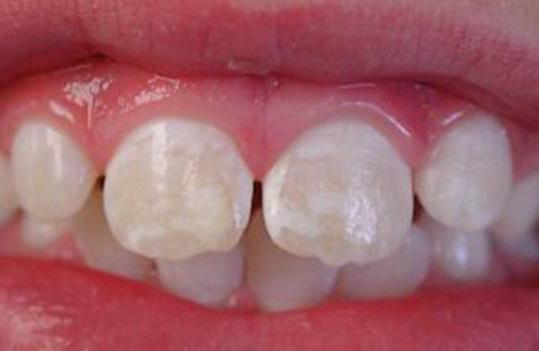
At the age of 2.5 years, a preventive procedure can be performed. It does not take much time and will not cause discomfort to the child.
After 3-4 years, full treatment should begin. At this age, you can come to an agreement with your child and establish contact. Dentist and parents find best option to solve the problem. It could be alternative to silver plating methods. Or treatment with a drill and
Why treat baby teeth?
Silvering of children's teeth has been carried out for many years. Reviews from parents are in some cases negative. They consist in denying the effectiveness of treatment of baby teeth. If teeth fall out, why treat them or carry out preventive procedures?
You should know that caries is an infection whose focus is located in the oral cavity. It can cause diseases internal organs or aggravate existing ailments.
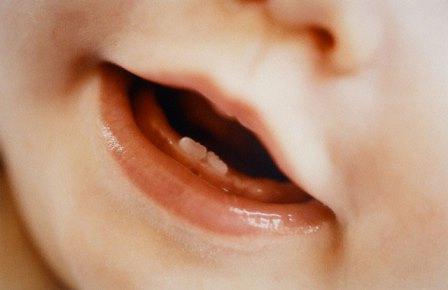
- After the birth of a child, you should not lick his nipples or spoons. If a parent has caries, it can be passed on to the child.
- Before the first teeth appear, wipe the baby’s mouth with moistened cotton pads or gauze.
- When teeth appear, brush them with a special children's brush (without toothpaste).
- Stop nighttime bottle feeding. Only normal is allowed drinking water if the child is naughty at night.
- It is better to give sweets in the first half of the day. This applies to sweet cereals, cookies, apples, bananas.
- Drink juices through a straw, no more than 100 g.
- Avoid candies, toffees, and carbonated drinks.
- Delay the appearance of chocolate on the table as much as possible (up to 3 years).
After sweets, be sure to rinse your mouth or brush your teeth with toothpaste (depending on the age of the child).
Healthy teeth promote quality chewing of food. They are involved in articulation and help correct sound pronunciation. Proper care for the oral cavity, will help avoid the appearance of caries.
Silvering children's teeth is one of the options conservative treatment carious process. This procedure is not able to cure caries, but it can be sufficient for a long time preserve pathological process and prevent partial or complete destruction tooth It should be understood that the silver plating process cannot replace a full-fledged surgical treatment carious process of the dentition.
Operating principle

Apply to the surface of the dentition thin layer 30% silver nitrate. This makes it possible to make the surface tissues of the tooth (dentin and enamel) denser for several months and, accordingly, protect them from destruction. Thus, the carious process of baby teeth is stopped and can be cured in time and completely.
Silvering of teeth is indicated for children if it is impossible to carry out full conservative (and surgical) dental treatment for a number of reasons. Typically this problem occurs when:
- the child is small (for example, a toddler) and is terrified of a person in a white coat, no persuasion works;
- Due to his personality traits, the baby cannot sit in one place for a long time, and a treatment session at the dentist involves staying in a chair for 1-2 hours.
A pronounced effect, that is, preservation of dental tissue in a certain state, can only be achieved as a result of regular procedures - 3-4 times a year.
Benefits of the silver plating procedure

This dental procedure has a fairly wide range of advantages, therefore it is becoming more and more popular among parents who consider it necessary to carry out quality treatment milk teeth.
Silvering of teeth in children:
- affordable in terms of price, it can be afforded (even repeat procedure) almost any family with a modest income;
- does not require highly qualified dentists and can be carried out, if technically possible, even by a novice doctor;
- quite effectively preserves dental tissue until full dental treatment is possible;
- can be used as a means of preventing the development of caries in primary teeth if the baby has an increased risk of developing this process (for example, both parents have widespread caries);
- the procedure is completely painless and safe, silver nitrate does not have any significant systemic effect even on the body of a very young child;
- the speed of the procedure will allow the child to avoid the development of a negative association with the dentist and his actions, but, on the contrary, will form the correct attitude towards the hygiene of his own dentition and mandatory prevention dental diseases and the need to take care of your own health.
The advantages and feasibility of the teeth silvering procedure should be clarified directly from pediatric dentist when examining a particular child.
Disadvantages of the silver plating procedure

Like any other procedure, silvering of baby teeth has, in addition to advantages, also disadvantages. Among them the most significant:
- change appearance dentition (teeth become dark), so the child may be teased or constantly asked questions about the color of the teeth;
- the film on the teeth is gradually erased under the influence of food consumption, so the protective film must be periodically restored;
- One should not expect a radical cure for caries as a result of silvering; this procedure only allows one to slow down the process of carious tooth destruction.
One more important feature The procedure for silvering the dentition is the need for early implementation. It is only possible to stop caries at the “stage” using silver nitrate. white spot"or "dark spot", that is, when we're talking about only about change surface layers tooth tissues. In case of deeper destruction or violation of the integrity of the tooth, silver plating is undesirable, since it can provoke a burn and further development of pulpitis.

Currently, the indication for this procedure is only one disease - caries, in particular initial stages this process.
Reviews from parents on numerous Internet resources are mostly positive. Parents note the suspension of the processes of tooth decay, that is, the actual achievement of the goal.
Dr. Evgeniy Komarovsky emphasizes that treating the dentition with silver nitrate is preventative, not medical procedure. Holding it on late stages caries (in case of tooth decay) or replacing full-fledged treatment with silver plating is unacceptable and impractical.

Modern dentists have not described any negative consequences, either systemic or local (for teeth only). This procedure It has been used for quite a long time (several decades in different countries of the world) and enjoys deserved popularity both among specialists and among parents of young patients.
The only one negative consequence(temporary) is a change in the appearance (blackening) of the dentition. This is what can cause psychological discomfort in a child, especially in a group environment.
Modern pediatric dentists offer only 2 options alternative to the silver plating process: deep fluoridation and remineralization.

Remineralization is the saturation of tooth enamel minerals. A prerequisite for a successful procedure is thorough cleaning of the surface of the dentition. It is advisable to carry out the cleansing process in a dental office, which is not always possible for a very young patient. The remineralization process itself can be carried out both in the dental chair and at home. One more prerequisite is compliance with all hygienic rules for caring for the entire oral cavity.
Deep fluoridation involves saturating weakened dental tissues with fluoride. This procedure should only be carried out in a dental office, as the drugs are quite toxic.
It is very important to prevent it in time childhood caries, so the child should be taken to the dentist regularly for examinations. Today there are quite a few preventive measures, aimed at preserving primary incisors and canines. One of the highest quality procedures for restoring enamel includes restoring teeth using special preparations.
What is silvering of baby teeth?
Coating enamel with preparations that contain silver is called silver plating. This metal has an antibacterial effect, which guarantees reliable, painless protection of the hard tissues of primary canines and incisors. Silvering teeth in children is a proven technique that allows you to stop caries at initial stage development (chalk spot stage).
The main reasons for the destruction of enamel in a baby:
- genetic predisposition;
- improper care oral cavity;
- unbalanced, unhealthy diet.
Advantages of the technique
Before signing up for teeth silvering for children, you need to find out how much positive aspects this procedure has. The main advantages of treating enamel with preparations containing precious metals are:
- such prevention does not require anesthesia;
- does not take much time and does not cause pain;
- silvering of teeth in young children preserves baby canines, incisors, molars, so the molars will grow strong and healthy;
- preventive restoration is allowed even for infants;
- Silver ions are non-toxic, which means silver plating is completely safe.
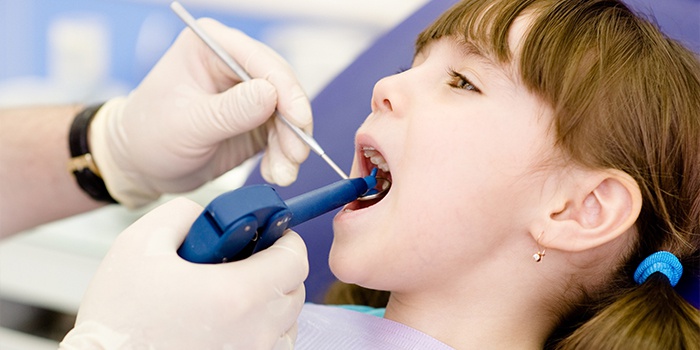
How does the procedure work?
How to treat dental caries using silver ions? What is this healing technique? To carry out the restorative procedure, the dentist uses 30 percentage solution silver nitrate. It creates a reliable protective film over the entire surface, protecting the enamel from destruction. The process of silvering teeth in children is carried out according to a specific sequential scheme, but before this mandatory training oral cavity.
The protective shell is carefully and thoroughly removed from plaque using a cotton swab (this is necessary in order to medicinal solution evenly distributed over a clean surface). Then a preparation with silver ions is applied to the damaged teeth. Often, for maximum and 100% effect, you need to go through 3-4 approaches of silvering. The number of approaches is determined by the doctor. After about six months, prevention must be repeated.
Contraindications
Before enrolling your child for treatment, it is better to discuss all the details with the dentist. As is the case with any other medical procedure, silvering also has several contraindications:
- caries can affect dentin - connective tissue, which makes up the main part of the tooth along its entire length (prevention in this case is prohibited);
- allergic reaction to components medicinal drug;
- age category child no more than 4 years old;
- the presence of somatic ailments (caused by external factors or internal malfunctions of organs; not related to mental state person).
Where to do it and how much it costs to silver a child’s teeth
Many parents are interested in the “price of the issue.” Modern technique silvering enamel (for one tooth) costs on average from 100 to 400 rubles. The cost often depends on the specific dental clinic and the drug that will be selected for the procedure. Enamel restoration in a private hospital domestic compounds is 150-200 rubles, imported - from 400 to 600 rubles. State pediatric dentistry conducts free treatment, but only if Russian or Belarusian-made medicines are used for this.
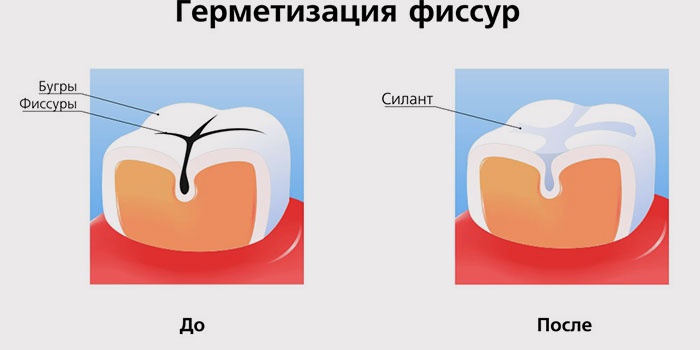
Are there alternative methods for treating dental caries?
Caries of baby teeth can be cured with other alternative ways, which provide an excellent chance to protect the enamel from destruction and get a guarantee of healthy permanent teeth. The most well-known methods of tissue restoration, besides silvering, are the following:
- Fluoridation (remineralization). This procedure completely “revitalizes” the protective shell, but, unfortunately, does not always give a long-lasting effect. It is carried out for children under 6 years of age. The essence of the technique: applied to the surface of the affected teeth. special paste, which contains substances contained in enamel.
- Ozonation – as medicine ozone is used. The procedure effectively prevents infection from entering the deep layers of tissue and kills harmful microbes in the oral cavity.
- Fissure sealing is a relatively new, effective method of getting rid of caries. Baby teeth are processed with a special drug, which thoroughly strengthens the enamel, protecting it from the development of the disease.
Video: why children’s teeth are silvered - Dr. Komarovsky
Photos before and after the procedure
